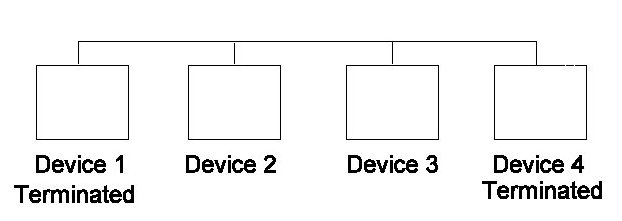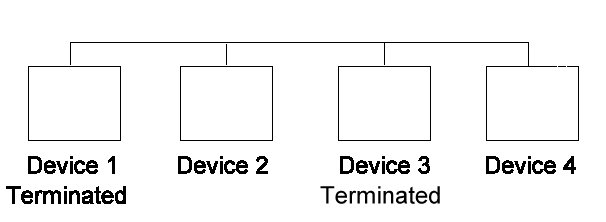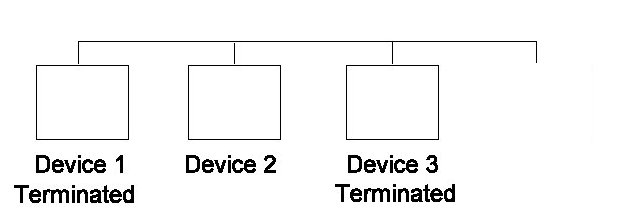
SCSI FAQ (Frequently Asked Questions)
SCSI stands for Small Computer Systems Interface. It's a standard for connecting peripherals to your SCSI controller, which uses standard SCSI commands. SCSI is available is several versions, SCSI-1, SCSI-2, SCSI-3, SCSI-4 and variations, SCSI Fast, Wide, Ultra, LVD (Low Voltage Differential), Single Ended and Differential (as well as Serial which is due to appear in 2003/4).
It basically consists of a controller and at least one device connected via
a cable. All the attached SCSI devices communicate along the same cable.
The Devices share the cable, and the SCSI communications protocol arbitrates
to decide who has access.
SCSI operates by send 16 bits of data (or 8bits with SCSI-1 and SCSI-2 narrow
versions) at a time down the cable. This makes cabling and the correct termination
very important as variation in either can cause signals to "skew".
This
means some of the data "bits" may arrive earlier than the rest causing data errors
at the receiving device.

Up to 8 devices (and 16 devices with Wide or LVD SCSI) can be attached to a
SCSI cable.
Of course one device must be the SCSI Controller, allowing another 7 (or 15
with Wide/LVD SCSI) to be connected.
Each device has an unique ID number, from 0 to 7 (or 0 to 15).
SCSI controllers are usually set to ID 7 which have the highest priority. Tape drives or other time sensitive
devices are usually set to 5 or 6 as this gives them a higher priority than
devices set to 0-4. Due to the original limitation of 8 ID the priority order
was 7 (highest) to 0 (lowest)
When wide SCSI allowed IDs from 0 to 15 the priority became (highest to lowest) 7-6-5-4-3-2-1-0-15-14-13-12-11-10-9-8
As a signal is sent along the cable, when it reaches the end, it may be reflected back along the cable causing interference with the next signal. For this reason each end of the SCSI cable must be terminated. The terminators basically try to ensure that signal is not reflected back along the cable. There are several type of termination: Passive, Active, and Forced Perfect.
SCSI-1 was first released in 1986. It allows for communications at 5MHz speed using a cable carrying 8 data bits (1 Byte) simultaneously, so it gave an effective rate of 5Mbytes/sec.The standard cable is 50pin, allowing for the data, and other communications signalling.
SCSI-2 was superseded by SCSI-2. It specified CDROM, Scanner and other commands in the
SCSI-2 Command set. It also has allowance for doubling the clock rate to 10MHz giving a
10Mbyte/sec transfer rate (known as Fast SCSI), and for doubling the number of Data bits
carried to 16 (2 bytes) (known as Wide SCSI).
Fast SCSI allows for a 10Mbyte/sec transfer rate, and is also still compatible with
SCSI-1, dropping back to a 5Mb/sec transfer rate if required.
SCSI-2 has Fast Wide SCSI which doubled the number of data line to 16 bits, and doubled the clock rate from 5MHz to 10MHz. This effectively gives a transfer rate of 10MHz x 2 bytes = 20MBytes/sec. Due to the extra data lines required, the cable is now 68 pin, so it will not physically connect to an 8bit SCSI device. However, Fast Wide SCSI allows for communications to determine if attached devices are 8 or 16 bit, so with a 68 pin to 50 pin adaptor it is possible to run an 8 bit SCSI-2 devices from a 16 bit Wide controller.
As well SCSI-2 is available in Single Ended and Differential Versions. The single ended is the most common type and uses a 5Volt signal for the SCSI cable. The differential model uses a higher voltage, which allows for longer cabling lengths. NEVER plug a differential drive or controller onto a single ended drive or controller. The higher voltage will damage the Single ended units electronics.
SCSI-3 provides for additional enhancements. With it comes Ultra SCSI which doubles the
clock speed again to 20MHz.
This means 8 bit or "Narrow" SCSI transfers at 20Mbytes/sec, and Ultra Wide at
40Mbytes/sec. With the gain in speed comes the disadvantage of shorter cable lengths. Ultra
SCSI cabling is limited to 1.5metres with up to 4 devices attached, and 0.5metres with 7
devices.
Further SCSI-3 enhancements are Ultra2 SCSI or Low Voltage
Differential (LVD). This doubles the clock speed again to 40MHz, so transfer rates are now
40MBytes/sec for Narrow Ultra2 SCSI and 80Mbytes/sec for Wide Ultra2 SCSI.
Normally this would have resulted in the maximum cable length being reduced
again. To avoid this, the signal voltage level has been doubled (the signal is
now +5 V or -5V) as well allowing for 3 meter cables. NOTE that this type of drive is
different to the DIFFERENTIAL drives mentioned previously. You cannot
connect Differential and Low Voltage Differential Drives together and the higher
voltage in the differential drive will damage the LVD components.
If you attach older SCSI-1, SCSI-2 or Ultra SCSI drives to the controller all LVD drives
will revert to Ultra mode, and you will be limited in cable length again.
A further enhancement is Ultra/160. This basically increases the data transfer rate to 80MHz (160Mbytes/sec) while using a 40MHz clock. In effect, you get twice the data transfer rate while not having to change the Ultra2 LVD cabling, although specifications for the LVD cabling have been "tightened", so some poorer quality LVD cabling may not work reliably.
The next enhancement is SCSI Ultra/320 which has doubled the transfer rate again.
Although cabling between Ultra160 and 320 may appear similar the primary difference is in the specification of the cabling. As the data speed has increased the electrical characteristics of the cable becomes more important. Cabling outside specification may cause data skewing (where some data bits are delayed due to variations in electrical impedance on some of the lines) and signal reflections in the cable. Some Ultra160 cabling may work at Ultra320 speeds, some may not.
Note also that the SCSI controller communicated directly with each device at
startup and determines transfer data rates and supported functions for each
device individually.
So if an Ultra320 SCSI controller is connected to an Ultra320 drive, and
Ultra160 drive and a Ultra80 (LVD) drive then it will transfer data at 320Mb/sec
to the Ultra320 drive, 160Mb/sec to the Ultra160 and 80Mb/sec to the LVD
drive.
Adding an Ultra2 Wide (40Mb/sec) drive will however cause the LVD bus to switch
to Ultra2 speeds and everything will then have an 40MB/sec maximum transfer
rate.
Fibre Channel is another SCSI-3 enhancement to be released. It allows for a 1Gb/sec, 2Gb/sec and recently 10Gb/sec transfer rates using either up to 30meters of copper cabling or up to 10km or fibre optic cabling. This provides the backbone for a SAN (Storage Area Network), with Servers, hard drives and other storage devices located on a separate network fibre network and all data storage is in a single physical pools. Each of the servers is provided with an allocation from the SAN data storage pool. This provides the advantage of easily reallocating storage capacity between servers, and allowing for a "serverless" backup with the tape system directly backing up the storage system. Fibre Switches and Hubs are available to control the fibre network and result in a network layout similar to a twisted pair Ethernet layout although all devices actually run in a ring type topology. They have the advantage of providing a large amount of available data space, and due to the Fibre channel protocols, can sustain very high data transfer rates, making them ideal for a central storage pool. Their disadvantage is in the cost of implementing a SAN which requires Fibre Channel switches and control software. Fibre channel systems tend to be proprietary, and expensive
As a signal is sent along the cable, when it reaches the end, it may be reflected back along the cable causing interference with the next signal. For this reason each end of the SCSI cable must be terminated. The terminators basically try to ensure that signal is not reflected back along the cable. There are several type of termination: Passive, Active, and Forced Perfect.
Each end of a SCSI cable MUST be terminated and there MUST NOT be any terminated devices in between.
This is correct

This is not

As well it is the PHYSICAL END of the cable that must be terminated, not the last device. So you should put devices on each end of the cable and terminate them
The arrangement shown below is not acceptable.

There are 3 main types of terminators
Passive
This type uses an array of resistors to try to prevent signals being reflected back down
the cable. This type of terminator is usually used for lower speed SCSI-2 devices such as
tape units and CD-ROM drives.
Active
This type used an voltage regulator to try to hold the end of the cable at a
constant voltage, and absorb any signals reaching the end of the line. This is more
effective than the Passive Terminator, and is the usual type used on a SCSI bus.
As the
Active terminator requires power to work, it requires a device on the SCSI bus to
provide termination power to the bus. This is usually set by a jumper on the device.
Forced Perfect
This type is used mainly when there are SCSI bus errors occurring, and other
terminator types have not resolved the problem. The terminator attempts to force the
signal line to a specific voltage, and uses a voltage regulator configuration that acts
faster than an Active Terminator can. It also requires more power than an Active
terminator, and this may cause problems in the supply of termination power.
SCSI has Ultra/320 SCSI with 320Mb/sec and IDE has UltraDMA133 with a 133Mb/sec transfer rate, and more recently SATA drives with a 150Mb/sec transfer rate. Which is better?
SATA and SCSI are aimed at two different markets.
Firstly, no SCSI or IDE drive will achieve a sustained transfer rate of 320
or 150/133MBytes/sec.
All of these data rates are the maximum speed at which data can be transferred by the SCSI
or IDE bus.
There are no drives that can sustain this data transfer rate except for a very
short period of time when data is read from their internal disk caches.
The maximum transfer rate a drive can sustain depends on a number of factors
Spindle speed. This is the speed the drives disk actually spins at. This ranges from 5400rpm to 15,000rpm. The higher the speed the more often the data on the disk will be in the right position to be read by the drive heads, and the faster data can be transferred.
Average Access Time. This is the average time is takes to position the heads so that data can be read. The faster the better.
Cache Size. This is the size of the cache on board the disk drive itself. This does reach a point where doubling the size generates a very small boost in performance and is not worth the cost, but generally the bigger the better. It also assists in small bursts of data where you may actually achieve near maximum performance as data is read from cache rather than the drive.
Internal Transfer Rate. This is the speed that data can be transferred within the drive. This speed will be higher than the actual transfer rate of the drive as there is some overhead for protocol handling as data is transferred to the SCSI or IDE bus.
In a drive comparison of any manufacturers drives you will see that the SCSI drives will have higher ratings in all four categories against the SATA/IDE range. So the SCSI drive can physically transfer data faster than the SATA/IDE drive. You can expect about 8-10Mb/sec transfer rate for 5400rpm SCSI drives, 10-16Mbyte/sec transfer rate for 7200rpm SCSI drives, about 20-25Mbyte/sec for 10,000rpm SCSI drives and 30-35Mbyte/sec for 15,000rpm SCSI drives.
SCSI also has advantage in Command queuing where devices can carry out commands independent of the controller. This allows the controller to command the first SCSI device to find data and then send a command to a second device while the first device carries out its command and then notifies the controller when it has finished.
As well the SCSI controller is not dependant on the system processor and puts much less of a load on the CPU. IDE generates a much larger CPU load.
So SCSI offers higher performance, and handles multiple requests better, allows for a large number of devices, but is more expensive.
SATA/IDE is much cheaper, and is simpler to configure in a system.
SCSI is more suited to server configurations were you will have multiple users accessing data such as a server or in a database application, or where disk drive performance is the primary consideration.
SATA/IDE is more suited to workstations were there is a price/performance consideration. SATA can however suit an environment where large storage at a cost effective price is required. By configuring multiple SATA drives in a "Striped RAID 0" array performance can be increased by having multiple drives responding to data requests (providing a higher data throughput) and making a large amount of disk space available for data.
Ultra320 SCSI has been released allowing for a 320MB/sec data transfer rate. The SCSI specifications allow for the future release of Ultra640 as well doubling the transfer rate again. Ultra 640 is however will not eventuate due to issues with "data skewing" and the release of Serial Attached SCSI
The release of Serial Attached SCSI (SAS) overcomes the problem of "skewing" of parallel data bits on the cable by running all communications via a Serial interface. The SCSI committees are working on a future development of the Serial standard.
Serial Attached SCSI (SAS) is pin compatible with SATA allowing SATA drive caddies to be used in Serial SCSI. SAS controllers can also use SATA drives. Current SAS controllers operate at 3Gb/sec to 6Gb/sec and will scale up to 12Gb/sec in the next few years . A SAS controller can have up to 128 devices attached. There can be multiple controllers in a SAS configuration allowing for both redundancy in case of failure and increased performance.
The main difference between SAS and SATA continues to be the higher spindle speeds, faster access times, and higher transfer rates available in SAS drives. SAS continues to be the high performance storage system, while SATA arrays provide cost effective mass storage.
In another area is the release of iSCSI. This allows for the SCSI protocol to be used over an IP network. This means that iSCSI drive arrays can be consolidated at central points and accessed by servers anywhere in the room, building, country or world. It allows a SAN equivalent without the cost of Fibre networking and Fibre switches. Some of the iSCSI releases actually use SATA or SAS drives in the array, with the unit providing a iSCSI interface to the network. This allows for large amounts of cheap storage to be implemented anywhere on the network. it does however require some form of storage management system which can add significantly to the cost.
To access the Award One web site please click on the following Award One web site